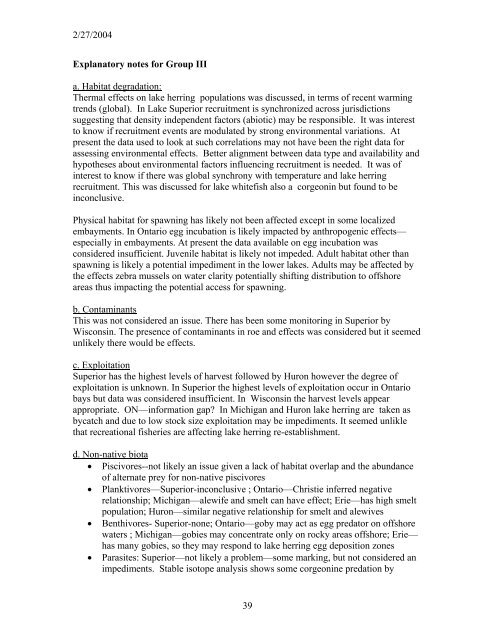Status and assessment, research, and restoration needs for lake ...
Status and assessment, research, and restoration needs for lake ...
Status and assessment, research, and restoration needs for lake ...
Create successful ePaper yourself
Turn your PDF publications into a flip-book with our unique Google optimized e-Paper software.
2/27/2004<br />
Explanatory notes <strong>for</strong> Group III<br />
a. Habitat degradation:<br />
Thermal effects on <strong>lake</strong> herring populations was discussed, in terms of recent warming<br />
trends (global). In Lake Superior recruitment is synchronized across jurisdictions<br />
suggesting that density independent factors (abiotic) may be responsible. It was interest<br />
to know if recruitment events are modulated by strong environmental variations. At<br />
present the data used to look at such correlations may not have been the right data <strong>for</strong><br />
assessing environmental effects. Better alignment between data type <strong>and</strong> availability <strong>and</strong><br />
hypotheses about environmental factors influencing recruitment is needed. It was of<br />
interest to know if there was global synchrony with temperature <strong>and</strong> <strong>lake</strong> herring<br />
recruitment. This was discussed <strong>for</strong> <strong>lake</strong> whitefish also a corgeonin but found to be<br />
inconclusive.<br />
Physical habitat <strong>for</strong> spawning has likely not been affected except in some localized<br />
embayments. In Ontario egg incubation is likely impacted by anthropogenic effects—<br />
especially in embayments. At present the data available on egg incubation was<br />
considered insufficient. Juvenile habitat is likely not impeded. Adult habitat other than<br />
spawning is likely a potential impediment in the lower <strong>lake</strong>s. Adults may be affected by<br />
the effects zebra mussels on water clarity potentially shifting distribution to offshore<br />
areas thus impacting the potential access <strong>for</strong> spawning.<br />
b. Contaminants<br />
This was not considered an issue. There has been some monitoring in Superior by<br />
Wisconsin. The presence of contaminants in roe <strong>and</strong> effects was considered but it seemed<br />
unlikely there would be effects.<br />
c. Exploitation<br />
Superior has the highest levels of harvest followed by Huron however the degree of<br />
exploitation is unknown. In Superior the highest levels of exploitation occur in Ontario<br />
bays but data was considered insufficient. In Wisconsin the harvest levels appear<br />
appropriate. ON—in<strong>for</strong>mation gap? In Michigan <strong>and</strong> Huron <strong>lake</strong> herring are taken as<br />
bycatch <strong>and</strong> due to low stock size exploitation may be impediments. It seemed unlikle<br />
that recreational fisheries are affecting <strong>lake</strong> herring re-establishment.<br />
d. Non-native biota<br />
• Piscivores--not likely an issue given a lack of habitat overlap <strong>and</strong> the abundance<br />
of alternate prey <strong>for</strong> non-native piscivores<br />
• Planktivores—Superior-inconclusive ; Ontario—Christie inferred negative<br />
relationship; Michigan—alewife <strong>and</strong> smelt can have effect; Erie—has high smelt<br />
population; Huron—similar negative relationship <strong>for</strong> smelt <strong>and</strong> alewives<br />
• Benthivores- Superior-none; Ontario—goby may act as egg predator on offshore<br />
waters ; Michigan—gobies may concentrate only on rocky areas offshore; Erie—<br />
has many gobies, so they may respond to <strong>lake</strong> herring egg deposition zones<br />
• Parasites: Superior—not likely a problem—some marking, but not considered an<br />
impediments. Stable isotope analysis shows some corgeonine predation by<br />
39
















